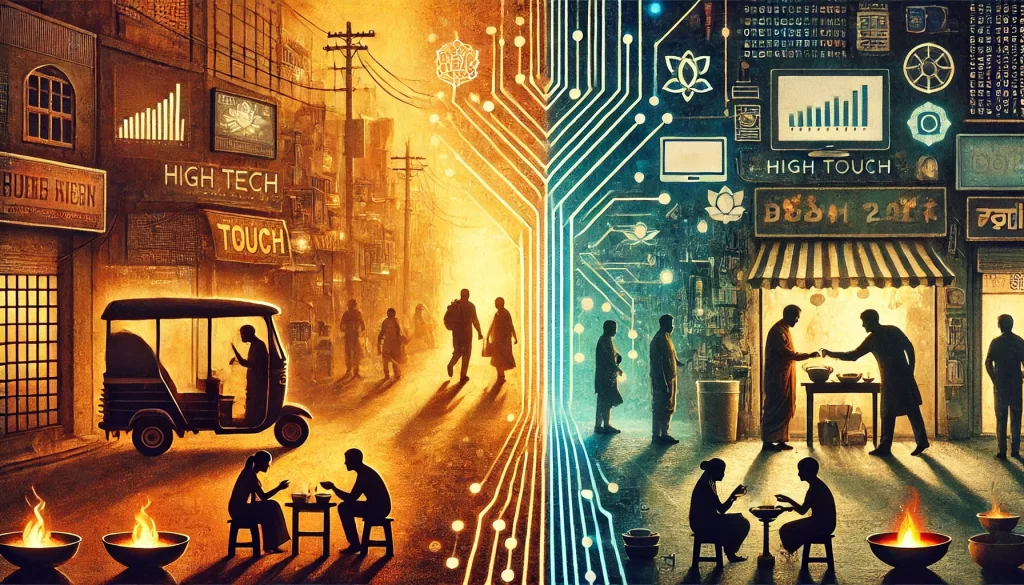
Over February and March this year, I spent a few weeks walking through India – part work, part wandering, part listening. In every conversation, every transaction, every quiet observation at the edges of the chaos, I found myself returning to one core truth: high touch will always, in the end, outlast and outvalue high tech.
This isn’t a rejection of technology.
Quite the opposite. I’ve spent enough time building systems, advising leaders, and guiding organizations through digital transitions to know that technology is an extraordinary multiplier. It can make things faster, more accessible, more consistent, and infinitely more scalable. But scale is not always the goal. Efficiency is not the same as effectiveness. And human connection – real, unfiltered, unautomated – is still the currency of trust, loyalty, and meaning.
India is, in many ways, the perfect lens through which to explore this idea. It’s a country of digital leaps. UPI payments are ubiquitous; AI is creeping into education, health, commerce. You can have groceries delivered to your door in ten minutes and prescriptions arrive via WhatsApp. Yet, the beating heart of India remains deeply, beautifully analog.
I found that business, over there, is still built on knowing someone’s name, asking about their family, offering an extra spoon of sugar in their chai because you remembered how they like it. Trust is not downloaded; it is built, over time, over conversations, over repeated acts of care. A shopkeeper doesn’t need an app to recognize you. A barber doesn’t need CRM software to know your last haircut. A street vendor doesn’t need loyalty points to know you’ll return tomorrow. The loyalty is already there – it’s personal, emotional, earned.
And it’s not just quaint or nostalgic. It’s strategic. Because high touch builds resilience. In a world full of choice and noise, it’s the human relationships that create the stickiness. That’s why luxury brands spend millions on “personalization.” That’s why Airbnb sends a handwritten note after your fifth stay. They’re all trying to recreate what India has still not lost: the feeling of being seen.
There’s a common fallacy in tech circles that human involvement is a bug, not a feature. That the future is “self-service” everything. But the more I observe, the more I believe the inverse has to be explored more. We don’t crave speed. We crave significance. We don’t remember transactions. We remember moments. And while technology can support and sometimes spark those moments, it cannot substitute for them. No chatbot has ever made someone feel truly understood.
This isn’t a binary. It’s a balancing act. The best organizations in the world are the ones that understand how to wield both. They use high tech to enable high touch. They use automation to buy time for their people to have better conversations. They let algorithms do the sorting so humans can do the relating.
The problem arises when we confuse convenience for connection. When we start believing that efficiency is the same as empathy. When we let dashboards replace dialogue. That’s when culture thins, brand erodes, and trust quietly walks out the back door. In relationships, personal or professional, being known is always more powerful than being serviced.
We often talk about “customer journeys,” but most of those maps forget the simple human truth: people remember how you made them feel. That’s why someone will walk past five stores to go to the one where they know the shopkeeper. That’s why a parent will send their child back to the same teacher or tutor, not because of curriculum, but because of care. And that’s why, even in an AI-saturated world, a thoughtful phone call still has the power to change the outcome of a negotiation, a sale, or a life.
High touch isn’t just about presence – it’s about emotional intelligence, contextual sensitivity, and choosing to engage where automation would be easier. It’s knowing when not to outsource a conversation to a chatbot. It’s understanding that the best insights often come not from a survey, but from a shared cup of tea. And most of all, it’s about remembering that people are not data points. They are stories in motion, looking to be acknowledged.
What India reminded me is that high touch is not a luxury – it’s a necessity, especially in a world that’s trying so hard to digitize everything. The more advanced we become, the more valuable the human layer becomes. Because machines can replicate patterns, but not presence. They can mimic tone, but not timing. They can predict behavior, but they cannot perceive meaning.
So yes, bring in the tech. But don’t forget that the algorithm can’t look you in the eye. And in the moments that matter, that’s all most people really want.